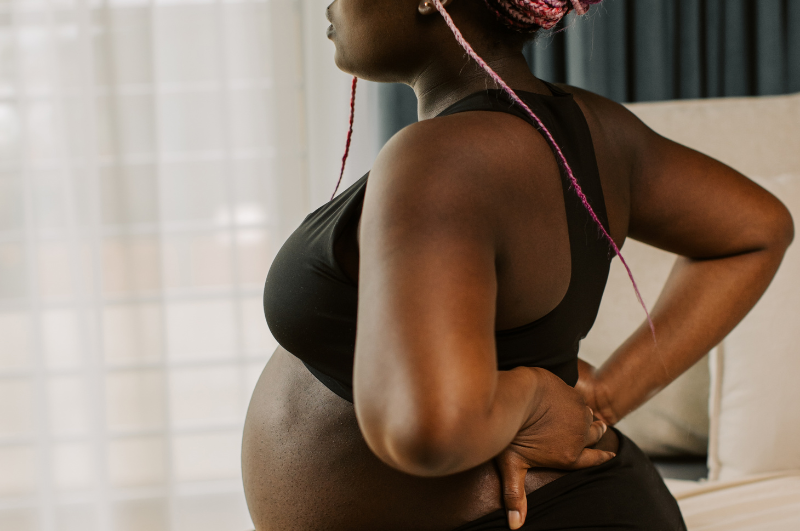Originally published in the Journal of Yoga and Physiotherapy
Volume 3 Issue 5 – January 2018
Sinéad Dufour, Assistant Clinical Professor, School of Rehabilitation Science, McMaster University, CanadaSubmission: January 17, 2018; Published: January 24, 2018*Corresponding author: Sinéad Dufour PT PhD, Assistant Clinical Professor, School of Rehabilitation Science, Director of Pelvic Health, The Worldof My Baby (WOMB), McMaster University, Canada, Email: sdufour@mcmaster.ca

Opinion:
Imagine you are 32 weeks pregnant with your first child and you start to have pain in the low back and pubic area when you change position, sit or stand for longer periods. The painmakes it very difficult for you to function and you worry about whether you can continue to work and manage your household.You are also concerned about the upcoming birth of your baby and whether you will be able to care for your baby, an often seemingly overwhelming task without having to deal with pain. Now imagine you have seen your health care provider and havebeen told that your pelvis is separating because of the “pregnancy hormones” and that you need to put up with this until after you have your baby, as “it will probably get better afterwards”. Imagine you are also told, to be careful because “your pelvis is unstable”. These are common words of advice or explanations pregnant women with pelvic girdle pain (PGP) receive from their healthcare providers, including physiotherapists. These words are not substantiated and do more harm than good.
Pelvic girdle pain (PGP) is defined as a specific type of low backpain that can occur with or without additional low back pain [1].Pregnancy-related PGP is a specific category of PGP impacting women in the perinatal period and differs in its etiology as it is related to pregnancy and associated biopsychosocial influences.It represents a prevalent condition with an incidence as high as 46-58% [2]. The cause of pregnancy-related PGP is complex and multifactorial [1,3]. Evidence has shown an alteration in motorcontrol in pregnant women [3] and more recently, central pain mechanisms have been considered and implicated [4-7]. As such,to appropriately address the complexity of pregnancy-related PGP, physiotherapists and others must both acknowledge and part with common yet unsubstantiated beliefs surrounding the concept of “pelvic instability” [8]. Instead, current advances in pain science support the notion that pregnancy-related PGP represents sensitization of the structures of the pelvis [4-7].Thus, attention must move away from biomechanics and engage the multiple underlying mechanisms such as the stress system (HPA axis) and associated coping, inflammatory load, status (HPA axis) and associated coping, inflammatory load, status of the gut microbiome and sleep quality to name a few [5-9]. Despite the evidence supporting the need for a biopsychosocialperspective, recent research demonstrates that when it comes to pregnancy-related PGP, physiotherapists continue to preferentially use a biomechanical approach [9,10]. Guidance for an evolved evidence-informed approach is available from the the most recent published CPGs for pregnancy related PGP [4]. From an assessment perspective, Clinton et al. [4] indicate the use patient reported outcomes as an important way to capture the various assessment domains relevant to pregnancy-related PGP[4]. Specifically, among other scales, the Pain Catastrophizing Scale (PCS) is recommended [4]. The PCS has three subscales:- rumination, magnification, and helplessness and has been utilized in various populations, including the antepartum population [11,12]. Using an outcome measure like the PCS is important to aid physiotherapists and others in assessing the mental processing that is associated with pregnancy-related PGP. The significance of patients’ beliefs and perceptions about their pain and their pain experience has been well demonstrated across a wide spectrum of orthopedic conditions including in the antepartum population [13]. Perception of pain has also been linked to the development of persistence [14-16], an important consideration for pregnancy-related PGP.
From a management perspective, it has been shown that pregnant women’s expectations of care are not met and that their knowledge about how to manage the condition is lacking [17]. Further, a recent qualitative study elucidated women’s experience of care for pregnancy-related PGP highlighting the importance of perceived hope and self-efficacy [18]. Thus cognitive care strategies that focus on pain neurophysiologyand stress response education [4,6], mindfulness-based stress reduction [19], and tailored exercise [3,4,6] are advocated.
Science has evolved and to clearly guide practice well beyond a biomechanical approach where pregnancy-related PGP is concerned. Physiotherapists well-positioned to educate PGP is concerned. Physiotherapists well-positioned to educate and empower women so they understand how to interpret and respond to the pain they are experiencing. Knowledge translation efforts to support the provision of evidence-informed care herein are needed.
References
1. Vleeming A, Albert HB, Ostgaard HC, Sturesson B, Stuge B (2008)European guidelines for the diagnosis and Treatment of pelvic girdlepain. Eur Spine J 17(6): 794-819.
2. Rost CCM, Jacqueline J, Kaiser A, Verhagen AP, Koes BW (2004) Pelvicpain during pregnancy. a descriptive study of Signs and symptoms of 870 patients in primary care. Spine 29(22): 2567-2572.
3. Stuge B (2012) Pelvic girdle pain: examination, treatment, and thedevelopment and implementation of the European guidelines. Journal of the Association of Chartered Physiotherapists in Women’s Health111: 5-12.
4. Clinton S, Newell A, Downey P, Ferreira K (2016) Pelvic girdle painin the antepartum population: Physical therapy clinical practiceguidelines linked to the international classification of functioning,disability, and health. section on women’s health and the orthopaedicsection of the American physical therapy association.
5. Bergström C, Persson M, Mogren I (2016) Sick leave and healthcareutilisation in women reporting pregnancy related low back pain and/or pelvic girdle pain at 14 months postpartum. Chiro& Man Ther 24: 7.
6. Smith MC, Ramirez LO, Clarke G, John FC, Higgins MF, et al. (2017)Stress reduction therapy improves symptoms of pregnancy-relatedpelvic girdle pain and reduces salivary cortisol. Irish Pain SocietyAnnual Research Conference, Aug 26th, Galway, Ireland.
7. Felice VD, Moloney RD, Cryan JF, Dinan TG, O’Mahony SM (2015) Visceralpain and psychiatric disorders. Mod Trends Pharmacopsychiatry 30:103-119.
8. O’Sullivan PB, Beales DJ (2007) Diagnosis and classification of pelvic girdle pain disorders – Part 1: A mechanism based approach within a biopsychosocial framework. Man Ther12(2): 86-97.
9. Shoskes DA, Wang H, Polackwich AS, Tucky B, Altemus J, et al. (2016) Analysis of gut microbiome reveals significant differences between men with chronic prostatitis/chronic pelvic pain syndrome and controls. J Urol 196(2): 435-441.
10. Vandyken C, Hilton S (2012) The Puzzle of pelvic pain: a rehabilitation framework for balancing tissue dysfunction and central sensitization – a review of treatment considerations. J Wom Health Phys Ther 36(1): 44-54.
11. Dufour S, Daniel S (2018) Understanding clinical decisio making: pregnany-realted pelvic girdle pain. J Wom Health Phys Ther IP.
12. Bergbom S, Boersma K, Overmeer T, Linton SJ (2011) Relationship among pain catastrophizing, depressed mood, and outcomes across physical therapy treatments. Phys Ther 91(5): 754-764.
13. Grotle M, Garratt AM, Krogstad Jenssen H, Stuge B (2012) Reliability and construct validity of self- report questionnaires for patients with pelvic girdle pain. Phys Ther 92(1): 111-123.
14. Vøllestad NK, Stuge B (2009) Prognostic factors for recovery from postpartum pelvic girdle pain. Eur Spine J 18(5): 718-726.
15. Noren L, Ostgaard S, Johansson G, Ostgaard HC (2002) Lumbar back and posterior pelvic pain during pregnancy: a 3-year follow-up. Eur Spine J 11(3): 267-271.
16. Ostgaard HC, Zentherstrong G, Roos Hansson E (1997) Back pain in relation to pregnancy: a six-year follow up. Spine 22(24): 2945-2950.
17. Crichton M, Wellock V (2008) Pain, disability and symphysis pubis dysfunction: women talking. Evidence Based Midwifery 6(1): 9-17.
18. Stuge B, BerglandA (2011) Evidence and individualization: Important elements in treatment for women with postpartum pelvic girdle pain. Physiother Theory Pract 27(8): 557-565.
19. Crisp CD, Hastings Tolsma M, Jonscher KR (2016) Midfulness-based stress reduction for military wome27: 557-565.n with chronic pelvic pain. Mil Med 181(9): 982-989.





